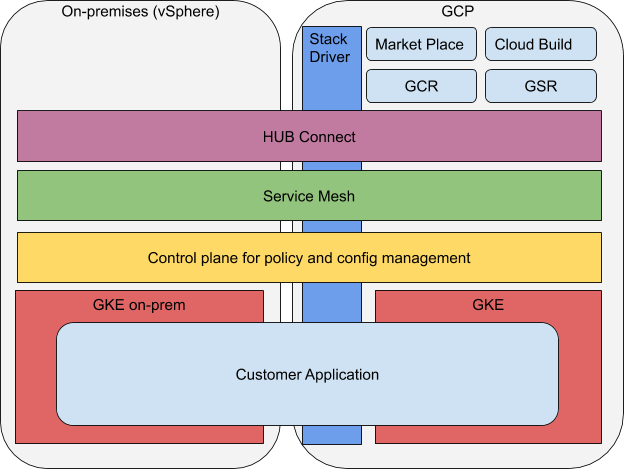Anthos: How Google changed the perception of hybrid cloud solutions
 More than half a year ago, Google announced a truly hybrid cloud solution - Anthos. It's time to recap and see how exactly Anthos has changed the perception of the hybrid cloud, what types of customers are benefiting from it and who will get the most out of it.
What exactly is Anthos?
Anthos is a platform that enables customers to build modern applications on top of a hybrid infrastructure. The consistency of the tools and experience of working with Google Cloud Platform (GCP) and on-premises environments allow a smoother transition of applications between environments to use the best from both worlds.
Anthos is a set of managed services with GCP GKE (Google Kubernetes Engine) at the core but extends the GKE to the customer’s environment so that it can be hosted on-premises (fully supported) as well as in third-party clouds (support for Amazon Web Services and Microsoft Azure is coming soon).
GKE is not the only component of Anthos and Google keeps adding new services to the list of Anthos-native managed services. Migrate for Anthos, multi-cluster management, Anthos Config Management, integration with Stackdriver, service mesh, support of Market Place, and Cloud Run are the services that create the Anthos ecosystem. All together, Anthos services create a complete set for customers to run their workloads across GCP and in on-premises environments or just on-premises, but most of the services will require connectivity back to GCP.
Anthos’ high-level architecture will help to understand how exactly Anthos and its components will blend into the existing customer’s environment.
More than half a year ago, Google announced a truly hybrid cloud solution - Anthos. It's time to recap and see how exactly Anthos has changed the perception of the hybrid cloud, what types of customers are benefiting from it and who will get the most out of it.
What exactly is Anthos?
Anthos is a platform that enables customers to build modern applications on top of a hybrid infrastructure. The consistency of the tools and experience of working with Google Cloud Platform (GCP) and on-premises environments allow a smoother transition of applications between environments to use the best from both worlds.
Anthos is a set of managed services with GCP GKE (Google Kubernetes Engine) at the core but extends the GKE to the customer’s environment so that it can be hosted on-premises (fully supported) as well as in third-party clouds (support for Amazon Web Services and Microsoft Azure is coming soon).
GKE is not the only component of Anthos and Google keeps adding new services to the list of Anthos-native managed services. Migrate for Anthos, multi-cluster management, Anthos Config Management, integration with Stackdriver, service mesh, support of Market Place, and Cloud Run are the services that create the Anthos ecosystem. All together, Anthos services create a complete set for customers to run their workloads across GCP and in on-premises environments or just on-premises, but most of the services will require connectivity back to GCP.
Anthos’ high-level architecture will help to understand how exactly Anthos and its components will blend into the existing customer’s environment.

Why was Anthos created?
Anthos is a way for applications and services that were born on-premises and in cold, dark datacenters to experience the true freedom of the public cloud. Anthos is Google’s way to show a path for an easy transition towards using cloud-managed services or on-premises services managed by the public cloud. One of the biggest challenges of the hybrid cloud is the consistency of the experience of working with on-premises and cloud infrastructures. Anthos is aiming to solve that problem by providing the consistency of experiences across different, non-common environments.
In addition to a solution for consistency of experience, Anthos helps customers with data residency limitations and meets a customer’s applications in the environment where data processing is possible. Industries like healthcare, finance, and government institutions are very careful with processing their data outside of their secure datacenter environments and this is where Anthos comes in handy because of its ability to run a modern application on-premises and leverage the power of tools that were previously only available in GCP.
Consistency of the tools for on-premises and the GCP environment makes Anthos a perfect platform for transitting applications into the public cloud or building modern applications across a hybrid environment.
Customers will benefit from using Anthos in the following ways:
- The ability to experiment with cloud-like services while keeping data in-house.
- The opportunity to have a playground and test environment to see how the application that was born in datacenters can operate in an environment that is very similar to a public cloud.
- A smoother transition towards using cloud infrastructure and segregate workloads that should be on-prem from the ones that can easily operate in the cloud and leverage unlimited scale capabilities.
- The adoption of tools that will work in the cloud environment the same good as in the cloud-native environment for future projects.
- The safety of trying and adopting new technology without doing a hard cutover.
Is Anthos a great fit for everyone?
Anthos is not a magic pill, but it can be in the right hands. Anthos has specific requirements for the customer’s infrastructure and hardware setup. Implementing Anthos will require teams to rethink the way the application is architected, structured, out of which components it is created and how they are talking to each other. The development lifecycle and engineering teams’ habits should change with Anthos to get the most out of using Microservice architecture, Dockerized environments, deployment strategies, and applications that are ready for scale and high loads.
Get ready for it.
Share this
Share this
More resources
Learn more about Pythian by reading the following blogs and articles.
Ansible dependencies for docker containers
SQL Injection with MySQL SLEEP()
Ansible Inventory Automation Using Consul and Orchestrator
Ready to unlock value from your data?
With Pythian, you can accomplish your data transformation goals and more.
